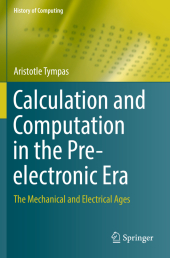 Neuerscheinungen 2019Stand: 2020-02-01 |
Schnellsuche
ISBN/Stichwort/Autor
|
Herderstraße 10
10625 Berlin
Tel.: 030 315 714 16
Fax 030 315 714 14
info@buchspektrum.de |

Aristotle Tympas
Calculation and Computation in the Pre-electronic Era
The Mechanical and Electrical Ages
Softcover reprint of the original 1st ed. 2017. 2019. xiv, 243 S. 23 SW-Abb. 235 mm
Verlag/Jahr: SPRINGER, BERLIN; SPRINGER LONDON; SPRINGER 2019
ISBN: 1-447-17410-0 (1447174100)
Neue ISBN: 978-1-447-17410-3 (9781447174103)
Preis und Lieferzeit: Bitte klicken
Although it is popularly assumed that the history of computing before the second half of the 20th century was unimportant, in fact the Industrial Revolution was made possible and even sustained by a parallel revolution in computing technology. An examination and historiographical assessment of key developments helps to show how the era of modern electronic computing proceeded from a continual computing revolution that had arisen during the mechanical and the electrical ages.
This unique volume introduces the history of computing during the "first" (steam) and "second" (electricity) segments of the Industrial Revolution, revealing how this history was pivotal to the emergence of electronic computing and what many historians see as signifying a shift to a post-industrial society. It delves into critical developments before the electronic era, focusing on those of the mechanical era (from the emergence of the steam engine to that of the electric power network) and the electrical era (from the emergence of the electric power network to that of electronic computing). In so doing, it provides due attention to the demarcations between-and associated classifications of-artifacts for calculation during these respective eras. In turn, it emphasizes the history of comparisons between these artifacts.
Topics and Features:
motivates exposition through a firm historiographical argument of important developments
explores the history of the slide rule and its use in the context of electrification examines the roles of analyzers, graphs, and a whole range of computing artifacts hitherto placed under the allegedly inferior class of analog computers
shows how the analog and the digital are really inseparable, with perceptions thereof depending on either a full or a restricted view of the computing process
investigates socially situated comparisons of computing history, including the effects of a political economy of computing (one that takes into account cost and ownership of computing artifacts)
assesses concealment of analog-machine labor through encasement ("black-boxing") Historians of computing, as well as those of technology and science (especially, energy), will find this well-argued and presented history of calculation and computation in the mechanical and electrical eras an indispensable resource. The work is a natural textbook companion for history of computing courses, and will also appeal to the broader readership of curious computer scientists and engineers, as well as those who generally just have a yearn to learn the contextual background to the current digital age.
"In this fascinating, original work, Tympas indispensably intertwines the histories of analog and digital computing, showing them to be inseparable from the evolution of social and economic conditions. " Prof. David Mindell, MIT
Introduction
The Delights of the Slide Rule
Lighting Calculations Lightened
Like the Poor, the Harmonics Will Always Be With Us
The Inner Satisfaction That Comes With Each Use of the Alignment Chart
The Appearance of a Neatly Finished Box
Conclusion
"Tympas (National and Kapodistrian Univ. of Athens, Greece) traces the story of analog computing devices in the preelectronic (or pre-digital) era, from the mid-19th century to the mid-20th century. ... Tympas´s meticulous attention to detail is demonstrated by the extensive references provided at the end of each chapter. All the references are united in a cumulative reference section at the end of the book. There is also a well-constructed, useful index. ... Recommended. Upper-division undergraduates and above." (J. Beidler, Choice, Vol. 56 (1), September, 2018)


